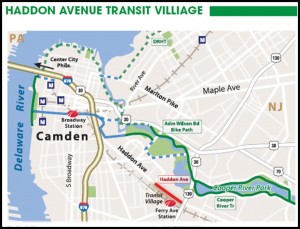Your weekly guide to heroic and villainous actions in tri-state transportation and development.
Winners

Camden, New Jersey—Camden’s Haddon Avenue Transit Village took a big step forward after New Jersey approved a sizeable tax credit for the transit-oriented development.
New York State Assembly Member Andrew Hevesi and New York League of Conservation Voters President Marcia Bystryn—Assemblyman Hevesi and Bystryn penned an op-ed in the New York Daily News outlining the dire consequences transit riders would face if the recent ruling striking down the MTA-supporting payroll mobility tax is upheld (full disclosure: Bystryn is a Tri-State board member). The MTA has appealed the decision.
ConnDOT—With a public hearing on the Stamford Transportation Center transit-oriented development project scheduled for tomorrow, the agency should be applauded for pursuing the sustainable transportation initiative. If done right, the project could lead to better land use and commuter access at one of the New Haven Line’s busiest hubs.
New York City pedestrians and drivers—The city is pulling in 33% less revenue from its red light camera program, which means that the safety technology is working.
Losers
2014 Super Bowl attendees—Although officials at a “Meadowlands Mobility” event said that “mass transit should be the primary way fans get to the [2014 Super Bowl],” which will be held at MetLife Stadium in the Meadowlands, nobody has publicly identified the funding stream that would pay for enhanced transit service to the underserved area.
Forest City Ratner—Atlantic Yards Watch has revealed that the neighborhood near Brooklyn’s Barclays Center has been plagued by regulation-flouting trucks in the area on construction business, a condition that has reportedly grown even as project developer Forest City Ratner assumed control of an arena loading dock earlier this month. “With apparently no enforcement taking place,” AYW writes, “the consequence is a wide range of adverse impacts on the community: trucks idling for long periods; use of unauthorized truck routes; and blocking of bus lanes, bike lanes, no standing zones and travel lanes. Travel and the quality of life on Dean Street between Flatbush and 6th Avenue is particularly affected.”

You applaud ConnDOTs TOD at Stamford’s train station. Have you paused to think about why so msny commuters oppose it? Could it be that the deals are being cut behind closed doors, in secret, with no input from taxpayers or commuters? Could it be that many commuters have said that they will go back to driving and stop using the train to NYC or within Connecticut as the parking is moved away from the station? Could it be because Amtrak riders with luggage don’t want to drag it through the New England snow that covers the ground here from November to March? We all support the future promise ofTOD but not at the expense of current commuters or to enrich developers.
I agree that moving the primary parking garage to over a 1/4 mile away will kill the reason the Stamford Station is so successful now.
If a garage over is not right adjacent to the station, it must be connected by an enclosed weather controlled walkway. THAT WALKWAY MUST HAVE A MOVING SIDEWALK SYSTEM to make the schlepp from the garage to the station reasonable for elderly and handicapped riders with luggage for both AMTRAK and Metro North.
You would be surprised how many Metro North riders come with overnight bags to CT on a Friday for weekend to visits to family and friends to go home or just to get out of NY for a weekend.